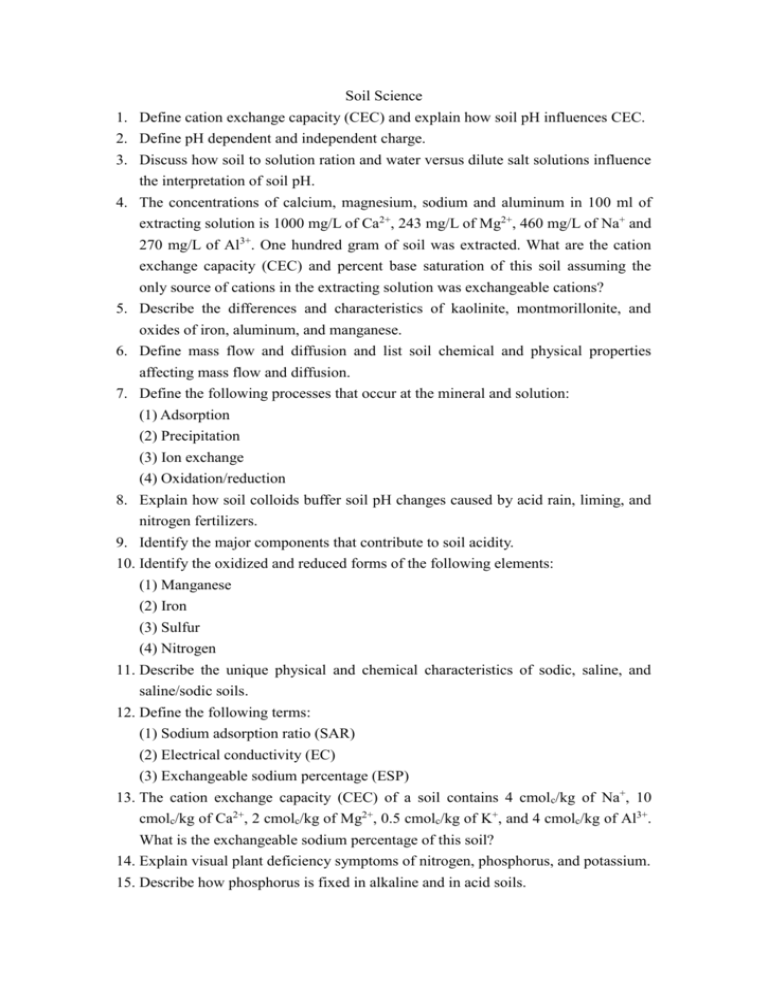Soil Science Define cation exchange capacity (CEC) and explain
advertisement

Soil Science 1. Define cation exchange capacity (CEC) and explain how soil pH influences CEC. 2. Define pH dependent and independent charge. 3. Discuss how soil to solution ration and water versus dilute salt solutions influence the interpretation of soil pH. 4. The concentrations of calcium, magnesium, sodium and aluminum in 100 ml of extracting solution is 1000 mg/L of Ca2+, 243 mg/L of Mg2+, 460 mg/L of Na+ and 270 mg/L of Al3+. One hundred gram of soil was extracted. What are the cation exchange capacity (CEC) and percent base saturation of this soil assuming the only source of cations in the extracting solution was exchangeable cations? 5. Describe the differences and characteristics of kaolinite, montmorillonite, and oxides of iron, aluminum, and manganese. 6. Define mass flow and diffusion and list soil chemical and physical properties affecting mass flow and diffusion. 7. Define the following processes that occur at the mineral and solution: (1) Adsorption (2) Precipitation (3) Ion exchange (4) Oxidation/reduction 8. Explain how soil colloids buffer soil pH changes caused by acid rain, liming, and nitrogen fertilizers. 9. Identify the major components that contribute to soil acidity. 10. Identify the oxidized and reduced forms of the following elements: (1) Manganese (2) Iron (3) Sulfur (4) Nitrogen 11. Describe the unique physical and chemical characteristics of sodic, saline, and saline/sodic soils. 12. Define the following terms: (1) Sodium adsorption ratio (SAR) (2) Electrical conductivity (EC) (3) Exchangeable sodium percentage (ESP) 13. The cation exchange capacity (CEC) of a soil contains 4 cmolc/kg of Na+, 10 cmolc/kg of Ca2+, 2 cmolc/kg of Mg2+, 0.5 cmolc/kg of K+, and 4 cmolc/kg of Al3+. What is the exchangeable sodium percentage of this soil? 14. Explain visual plant deficiency symptoms of nitrogen, phosphorus, and potassium. 15. Describe how phosphorus is fixed in alkaline and in acid soils. 16. The exchangeable Al3+ acidity of a soil is 20 mmol/kg and the pH is 4.5. In order to reduce exchangeable Al3+ acidity to 5 mmol/kg, or 15 mmol/kg less than current, how much liming material or CaCO3 would be needed to neutralize that amount of acidity? 17. Describe the importance of the following on soil sampling results: (1) Time of year (2) Landscape position (3) Past land management practices (4) Depth 18. If a soil test recommendation is for 56 kg P and 224 kg K per hectare, how much single superphosphate (0-20-0) and potassium chloride 0-0-60 would you apply? 19. List the USDA soil particle size classes. 20. A soil core is taken using a core (ring) that has a 2 cm diameter and is 10 cm tall. The core weights 22.5 g and the moisture tin used for drying the core weights 65.2 g. The total wet weight of the soil, core and moisture tin is 136.3 g and the dry weight is 128.6 g. Calculate the soil bulk density and porosity assuming that particle density is 2.65 g/cm3. 21. Describe how soil texture and structure influence water movement and water holding capacity. 22. 26 g of wet soil is placed in a container weighing 2 g. After drying the container plus soil weighs 23 g. Calculate the gravimetric and volumetric water contents assuming that this soil has a bulk density of 1.2 g/cm3? 23. Describe how water infiltration and percolation are affected by soil bulk density, porosity, structure, and texture. 24. Describe how soil color, soil water content, surface residue, and landscape position affect soil temperature. 25. Explain how soil bulk density, particle density, porosity, and structure influence soil aeration. 26. Describe how soil compaction affects infiltration, permeability, bulk density and thermal conductivity. 27. Describe the five soil forming factors. 28. Describe the following terms: (1) Argillic (2) Oxic (3) Natric (4) Spodic 29. Define hue, value, chroma and Munsell notation. 30. Define the master horizons of a soil profile. 31. Explain how soil structure, texture, color, and bulk density vary with soil depth. 32. Explain the following diagnostic surface epipedons: (1) Histic (2) Melanic (3) Mollic (4) Umbric 33. Name the major groups of soil microorganisms and group these microorganisms according to how they obtain their carbon and energy. 34. Discuss how normal changes in temperature, organic matter level, moisture potential, and pH affect soil microbial activity. 35. Describe the benefits to both the fungi and plant in a mycorrhizal symbiosis. 36. Explain why microbial biomass and its activity reduce with intensive tillage. 37. Describe how soil pH, inorganic nitrogen, moisture content, and micronutrients influence the nodulation of leguminous and actinorhizal plants. 38. Discuss the nitrogen cycle. 39. Describe how the rate of decomposition of organic materials varies based on C:N ratio, lignin content, size of residue, and clay content. 40. Define the following terms related to the nitrogen cycle: (1) Nitrification (2) Denitrification (3) Immobilization (4) Mineralization 41. Discuss the biological, physical, and chemical properties imparted to soil by organic matter. 42. Describe how soil management, texture, precipitation, and temperature affect the amount of organic matter present in soil. 43. Define and describe bioremediation and phytoremediation. 44. Describe how microbial activities impact the production of greenhouse gases. 45. Identify soil conditions that contribute to soil erosion by water. 46. Explain the effects of residue management on soil erosion. 47. Define soil quality and describe how organic matter, pH, bulk density, and biological activity affect soil quality. 48. Describe methods to improve plant growth on saline and sodic soils. 49. Describe the soil properties and management practice used to reduce mobility of heavy metals in land applied with municipal biosolids, effluents and industrial wastes. 50. Describe water conservation practices used to reduce the frequency of irrigation.







